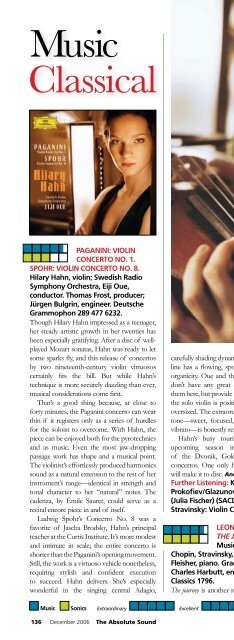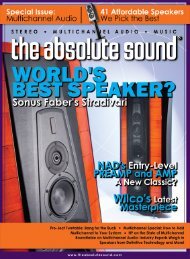Create successful ePaper yourself
Turn your PDF publications into a flip-book with our unique Google optimized e-Paper software.
Music<br />
Classical<br />
Paganini: Violin<br />
Concerto No. 1.<br />
Spohr: Violin Concerto No. 8.<br />
Hilary Hahn, violin; Swedish Radio<br />
Symphony Orchestra, Eiji Oue,<br />
conductor. Thomas Frost, producer;<br />
Jürgen Bulgrin, engineer. Deutsche<br />
Grammophon 289 477 6232.<br />
Though Hilary Hahn impressed as a teenager,<br />
her steady artistic growth in her twenties has<br />
been especially gratifying. After a disc of wellplayed<br />
Mozart sonatas, Hahn was ready to let<br />
some sparks fly, and this release of concertos<br />
by two nineteenth-century violin virtuosos<br />
certainly fits the bill. But while Hahn’s<br />
technique is more securely dazzling than ever,<br />
musical considerations come first.<br />
That’s a good thing because, at close to<br />
forty minutes, the Paganini concerto can wear<br />
thin if it registers only as a series of hurdles<br />
for the soloist to overcome. With Hahn, the<br />
piece can be enjoyed both for the pyrotechnics<br />
and as music. Even the most jaw-dropping<br />
passage work has shape and a musical point.<br />
The violinist’s effortlessly produced harmonics<br />
sound as a natural extension to the rest of her<br />
instrument’s range—identical in strength and<br />
tonal character to her “natural” notes. The<br />
cadenza, by Émile Sauret, could serve as a<br />
recital encore piece in and of itself.<br />
Ludwig Spohr’s Concerto No. 8 was a<br />
favorite of Jascha Brodsky, Hahn’s principal<br />
teacher at the Curtis Institute. It’s more modest<br />
and intimate in scale; the entire concerto is<br />
shorter than the Paganini’s opening movement.<br />
Still, the work is a virtuoso vehicle nonetheless,<br />
requiring stylish and confident execution<br />
to succeed. Hahn delivers. She’s especially<br />
wonderful in the singing central Adagio,<br />
carefully shading dynamics so that the melodic<br />
line has a flowing, spontaneously developing<br />
organicity. Oue and the Stockholm orchestra<br />
don’t have any great demands placed upon<br />
them here, but provide solid support. Sonically,<br />
the solo violin is positioned forward but isn’t<br />
oversized. The extraordinary beauty of Hahn’s<br />
tone—sweet, focused, without overwrought<br />
vibrato—is honestly reproduced.<br />
Hahn’s busy touring schedule for the<br />
upcoming season includes performances<br />
of the Dvorák, Goldmark, and Korngold<br />
concertos. One only hopes that all of these<br />
will make it to disc. Andrew Quint<br />
Further Listening: Khachaturian/<br />
Prokofiev/Glazunov: Violin Concertos<br />
(Julia Fischer) (SACD); Brahms/<br />
Stravinsky: Violin Concertos (Hahn)<br />
Leon Fleisher:<br />
the journey.<br />
Music by Bach, Mozart,<br />
Chopin, Stravinsky, Beethoven. Leon<br />
Fleisher, piano. Grace Row, producer;<br />
Charles Harbutt, engineer. Vanguard<br />
Classics 1796.<br />
The journey is another reminder of how much<br />
Leon Fleisher was missed during his longenforced<br />
absence from two-handed piano<br />
playing before his miraculous recovery from<br />
focal dystonia. Time has ripened his art and,<br />
like his earlier Vanguard disc, this recital is an<br />
indispensable addition to a discography that<br />
includes some of the finest piano recordings<br />
of the past half-century.<br />
Bach is represented by the Capriccio,<br />
“On the Departure of a Brother,” and the<br />
Chromatic Fantasy and Fugue, both played with<br />
technical aplomb and a knowing combination<br />
Music<br />
Sonics<br />
Extraordinary Excellent Good Fair Poor<br />
136 December 2006 The Absolute Sound










